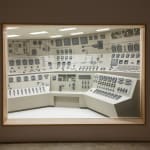Roxy Paine USA, b. 1966
Control Room - Diorama, 2013
Steel, wood, automotive paint, glass, fluorescent
Approx. 12.4 x 18.02 x 13.6 ft
3.7 x 5.4 x 4.1 m
3.7 x 5.4 x 4.1 m
3704
Further images
-
(View a larger image of thumbnail 1
)

-
(View a larger image of thumbnail 2
)

-
(View a larger image of thumbnail 3
)

-
(View a larger image of thumbnail 4
)

-
(View a larger image of thumbnail 5
)

-
(View a larger image of thumbnail 6
)

-
(View a larger image of thumbnail 7
)

-
(View a larger image of thumbnail 8
)

-
(View a larger image of thumbnail 9
)

-
(View a larger image of thumbnail 10
)

-
(View a larger image of thumbnail 11
)

-
(View a larger image of thumbnail 12
)

-
(View a larger image of thumbnail 13
)

-
(View a larger image of thumbnail 14
)

-
(View a larger image of thumbnail 15
)

-
(View a larger image of thumbnail 16
)

Moving away from his hyperreal resin sculptures and the perfect industrial sheen of his signature 'Dendroid' series (life sized trees rendered in stainless steel), Roxy Paine's exploration of dioramas began...
Moving away from his hyperreal resin sculptures and the perfect industrial sheen of his signature "Dendroid" series (life sized trees rendered in stainless steel), Roxy Paine's exploration of dioramas began the artist's new focus on wood as a medium. Looking at the machined, synthetic interiors of contemporary America, the warm wood dioramas give us pause to consider the most iconic, emblematic spaces with live with today. Beginning with his landmark exhibition Apparatus at Kavi Gupta in Chicago, which won the International Art Critics Association (AICA-USA) award for best commercial gallery show in the country, Paine set his sights on the abstract concepts of a "control room" and a "fast food restaurant" as subjects for meditation. Reproduced at 1:1 scale, the dioramas are not merely models, but highly illusory viewing rooms onto a static portrait of a spatial moment.
The Control Room is one of the most ambiguous of Paine's dioramas, a peculiar and curious space which is essentially legible be eludes specificity. The perspective is slightly tilted, giving the viewer a perspective something like a security camera looking into the space. The control panels are unlabeled and, as you look closer, incongruous: This is not a specific control room, but a symbol for "control rooms" in general, drawing influence from music studios, nuclear reactors, NASA mission control, and any number of other broad cultural concepts of what a "control room" might be. This blurred state of being also brings to question the degree to which dioramas themselves, as teaching tools and cultural signifiers, are actually rich with information or are just a mirror reflecting back to us the information we already know.
The Control Room is one of the most ambiguous of Paine's dioramas, a peculiar and curious space which is essentially legible be eludes specificity. The perspective is slightly tilted, giving the viewer a perspective something like a security camera looking into the space. The control panels are unlabeled and, as you look closer, incongruous: This is not a specific control room, but a symbol for "control rooms" in general, drawing influence from music studios, nuclear reactors, NASA mission control, and any number of other broad cultural concepts of what a "control room" might be. This blurred state of being also brings to question the degree to which dioramas themselves, as teaching tools and cultural signifiers, are actually rich with information or are just a mirror reflecting back to us the information we already know.
Provenance
The artist's studio, New York, NY, USAKavi Gupta gallery, Chicago, IL, USA
Exhibitions
Roxy Paine, Apparatus, 2013, Kavi Gupta, Chicago, IL, USARoxy Paine, Serotonin Reuptake Inhibitor, 2016, Beeler Gallery, CCAD, Columbus, OH, USA















